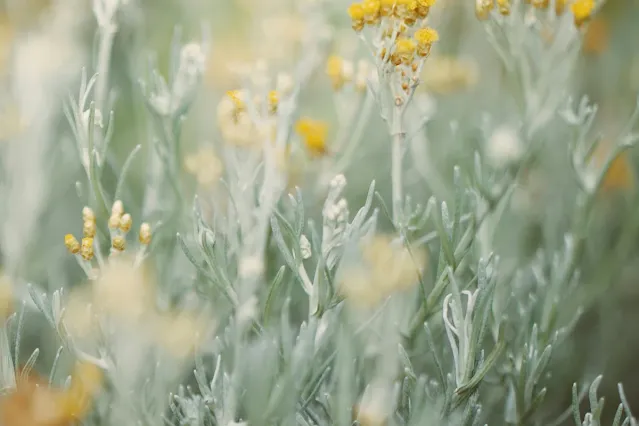Immortelle d’Italie (Helichrysum italicum), commonly known as the curry plant, is a striking Mediterranean herb cherished for its silvery-gray foliage and distinctive curry-like fragrance. Despite its name and scent, it is not related to the curry leaf plant (Murraya koenigii) used in Indian cooking.
This aromatic perennial is more than just a pretty face—its essential oils are prized in herbal medicine and aromatherapy for their anti-inflammatory and skin-rejuvenating properties. With its drought tolerance and ornamental appeal, the curry plant is a favorite in rock gardens, herbal borders, and dry, sunny landscapes across Europe and beyond.
Curry Plant Overview
- Botanical Name: Helichrysum italicum
- Family: Asteraceae (Daisy family)
- Mature Size: About 1 to 3 feet tall and wide (30 to 90 cm)
- Plant Type: Evergreen subshrub / perennial
- Sun Exposure: Full sun
- Soil Type: Well-drained, sandy or rocky soils; tolerates poor soil
- Bloom Time: Summer (typically June to August)
- Flower Color: Small yellow flowers
- Hardiness Zones: USDA zones 7–10
- Native Area: Mediterranean region
- Toxicity: Non-toxic to humans and pets
Topics Related To Plants:
How to Grow the Curry Plant
Choosing the Right Location
The curry plant thrives in full sun and is perfectly suited for Mediterranean-style gardens. It loves warm, dry conditions and performs best in USDA hardiness zones 7–10. If you live in a cooler climate, consider growing it in a container so it can be brought indoors during winter.
Soil Requirements
This hardy herb prefers well-draining soil, especially sandy or rocky mixes that mimic its native terrain. Avoid rich, moisture-retaining soils, which can lead to root rot. An alkaline to neutral pH (around 6.5 to 7.5) is ideal to keep the plant healthy and aromatic.
Planting from Seeds or Cuttings
While you can start the curry plant from seeds, it's often easier and more reliable to propagate it from semi-hardwood cuttings taken in late spring or early summer. For seeds, start them indoors early in the season, as germination can be slow. Once seedlings are strong enough or cuttings have rooted, transplant them outdoors when the risk of frost has passed.
Companion Planting & Landscaping Uses
Thanks to its low water needs and aromatic appeal, Helichrysum italicum fits beautifully into rock gardens, Mediterranean borders, and containers. It pairs well with other sun-loving, drought-tolerant herbs like lavender, rosemary, and thyme, creating a visually cohesive and fragrant planting scheme.
Topics Related To Garden:
How to Care for the Curry Plant
Watering Schedule
Once established, the curry plant is highly drought-tolerant, making it a great choice for low-maintenance gardens. However, newly planted specimens need regular watering until roots develop. After that, allow the soil to dry out between waterings. Overwatering can quickly lead to root rot, so it’s better to underwater than overdo it.
Sunlight and Temperature
Helichrysum italicum thrives with 6 to 8 hours of full sun each day. It handles heat and wind well, making it ideal for exposed locations. That said, it’s not frost-hardy—in cooler zones, either grow it as an annual or move potted plants indoors before temperatures dip.
Fertilization
The curry plant doesn’t need much feeding. Apply a low-nitrogen fertilizer once or twice during the growing season if needed, especially in poor soils. Over-fertilizing can reduce the intensity of its natural aroma and cause leggy growth.
Pests & Diseases
This plant is generally resistant to pests, thanks to its aromatic oils, which deter insects. The main threat is root rot, which occurs in waterlogged or poorly drained soil. Make sure containers and garden beds have excellent drainage to avoid this issue.
Pruning Tips
To keep your curry plant compact and healthy, prune it back after flowering. Regular trimming encourages a bushy growth habit and prevents the plant from becoming too woody or leggy. You can also harvest stems to dry or use in herbal preparations while shaping the plant.
Maintaining a Healthy Curry Plant Year-Round
Winter Care
In colder climates, the curry plant should be overwintered indoors or treated as an annual. Growing it in pots or containers makes it easy to relocate indoors before frost hits, protecting it from cold damage.
Harvesting & Uses
For the best fragrance, harvest stems just before flowering. The aromatic foliage is perfect for potpourri, herbal sachets, and even essential oil extraction, adding a lovely scent to your home and natural remedies.
Propagation for Renewal
To keep your curry plant vigorous, take semi-hardwood cuttings in late spring or early summer. Propagating new plants helps refresh aging specimens and maintain lush growth.
Long-Term Health
Over time, curry plants can become woody and sparse. To ensure continued vitality, consider replacing plants every few years or regularly propagating new ones from cuttings.





